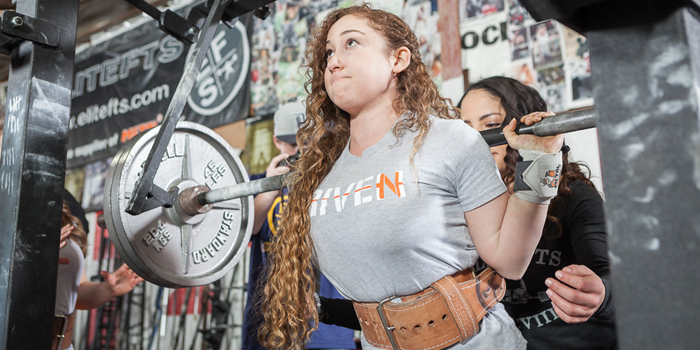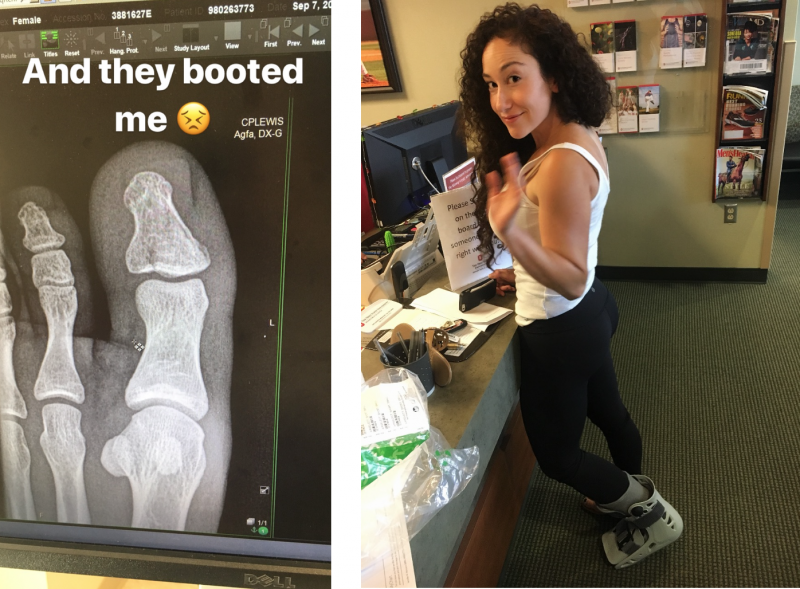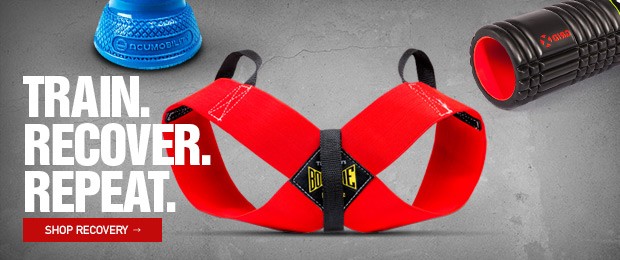
Recently, I had a pretty bad injury. I didn’t get it when I was training myself; I got it when I was training a horse. The horse hit an uneven patch of ground and tripped. I was on the horse when she tripped, so not only did we tip over, but she also fell on my foot. Lucky for her, she was fine. I, however, ended up with a fractured big toe, bone bruises in my calcaneus and ankle, and some torn-up ligaments. Basically, a busted foot.
Now, for anyone who knows me, you know I train HARD – like Buddy Morris hard. My first training goal isn’t gains, it’s literally mental health. Every other day of the week, you can catch me doing the Stairmaster and lifting at Powerhouse. And on the off-days, you can find me on the road running 5-8 miles with the dog. Personally, I think off-days are BS when it comes to my goals (disclaimer: they are critical for making training adaptations and getting bigger, faster, and stronger). But my training goals are rather dumb, so I don't suggest for anyone to train this way.
RECENT: Infrared Saunas: Fad or Fantastic?
So, as I’m sure you can imagine, I was wrecked a week later when the sports medicine doctor handed me a boot and told me that it was staying on. He told me not to put weight on my foot – no lifting, no running, no load-bearing things. I pouted as he basically told me to hang out and heal. But, I couldn't just “hang out” – it’s not in my DNA. So, you know what I did? I got on a baby horse the next morning, tried to see if I could climb the Stairmaster with the boot on the day after (before tossing it aside and justifying the decision by telling myself toes aren’t needed to Stairmaster), and applied a magic mix of anti-pain creams to keep me moving when I should have been sitting down. Over a three-week boot period, I still trained every day. And guess what – I still got better.
So, I’m going to be writing an article that by no means is medical or technical advice to anyone on how to keep training through an injury, but instead, it’s a story of how I handled mine. Why? Because I believe that sometimes, guidelines are meant to be broken. And I want to throw it out there that when you do, you can still get better. So, I’m writing this for the other crazies like me, who believe that you can train around just about anything.
Immediately Post-Injury
Almost everyone has heard that immediately following an injury (most sprains and strains), you should ice and rest. If you have read my past articles, you know that I'm all about allowing inflammation to occur because of its essentialness for repair. My foot started swelling as soon as I got home (no bruising yet), so I did a heat-ice combo. And by that, I mean I took an Epsom salt bath with my foot elevated in the tub, and then went to sleep with an ice pack wrapped around my foot. I also drank some whiskey for the pain, which was a solid call. I went to sleep pain-free, BUT woke up with a nicely-bruised balloon foot. So, what you can learn from this is that if you get injured and decide not to go to the emergency room (like me), icing is great to reduce inflammation, and heat can be beneficial to increase blood flow to the area to stimulate the healing process.

The First 24-48 Hours Post-Injury
Despite having a balloon foot, I was convinced that I didn't need to get it checked out with an X-ray. However, a doctor in the lab next to mine took one look at my foot and told me to call sports medicine to make an appointment – and so I did. Honestly, my best suggestion for anyone is if you think you have a fracture, you should go in and get it looked at. Why? Because it doesn't take much for a small fracture to become a full-blown one. And for people who love to train hard, knowing what you are dealing with is the best thing you can do if you want to train around it without making it worse. At the doctor, I found out that I had a fracture (my big toe), torn ligaments in my heel, and bone bruises to my ankle and calcaneus. That’s also when I was given my boot and told to refrain from load-bearing cardio and lifting, and to “take it easy”. But, like I said, this is my account of how to train around an injury – so here is how I proceeded.
Over the next two days, I went to see amazing chiropractor and rehab specialist Dr. Tyrel Detweiler at Hybrid Performance Group. We got to work rehabbing it, with the immediate goals being: 1) reduce swelling, 2) get blood flow into the area (to clear out the damage), and 3) minimize the pain. To do this, we used the following modalities:
- Compression Boots: Helps get the inflammation and swelling circulated out. Active compression enhances lymphatic drainage, which helps carry the cellular damage and waste away from the injury site.
- Electrical Stimulation (STIM): Increases blood flow to the injured area, which subsequently speeds healing by helping to clear inflammation. STIM also helps stimulate nerves to help decrease pain. It was especially helpful for my injury, since the foot and the ankle are two places that don’t get a ton of blood flow.
- Ultrasound: Increases local blood flow and reduces swelling. There is also some evidence suggesting it can help speed bone healing.
- Other: We taped up my ankle because I was dumb enough to ride my bike to his office, and I got adjusted because my neck was pretty out of alignment from the fall.
In the first 24 hours, I also tried to get some blood flow moving to the area using the rower. My justification was that it was forcing my ankle into flexion, and that would be good to help it keep its range of motion (ROM); it also let me get some cardio in. Post-ankle injury, it’s important to try to do whatever you can to maintain range of motion without further injuring it.
I also made a very (un)intelligent decision to get on a baby horse, because I reasoned that would also force my foot into greater ROM. This, of course, inflamed it, but Dr. Tyrel helped STIM the pain away. At 48 hours, I decided to try to do the Stairmaster with the boot on my foot. I suggest the latter for no one because every time I tripped, the boot jammed into my fractured toe, causing a ton of pain. Once again, Dr. Tyrel used STIM to help it go away.
So, what you can take away is likely this: 24-48 hours post-injury, it’s important to get the swelling down, keep the inflammation in check, and maintain the best ROM you can (without further hurting yourself). I should also note that I was applying topical Arnica daily, and that is something that I think is great. Arnica is a homeopathic gel that reduces arthritis symptoms, pain, swelling, and bruising.
The Next Two Weeks
I continued to go to Dr. T for weekly treatments of the same type mentioned above, and watched daily as the toe and heel hurt less and less. I think being adamant about implementing recovery modalities made a huge difference in how quickly my recovery went and is going. I soon started progressively overloading my “fragile foot” training at the gym. By this, I mean I added progressively higher degrees of difficulty to my cardio each day. For example, my first cardio session was done in the boot. But once I realized how terrible of an idea this was, I took it off and walked slowly on the Stairmaster for 20 minutes one day, then 40 minutes, and then 60 minutes. When I hit 60 minutes successfully (no pain), I then added a weight vest and progressed again (slowly).
In the gym, I avoided loaded lower body (minus leg extensions, leg curls, and the booty blaster) for one full week. On week two, I added in some light things like good mornings, cable pull-throughs, and air squats. Admittedly, I continued my upper training as normal, minus push-ups (because I wanted to keep weight off of my toe). I also kept riding, because I reasoned that it was my ankle mobility exercise (trust me, I can justify anything). After two weeks, I went to the surgeon and found out that I was clear to do activities like walking and light lower-body lifting. The takeaway from this should be that when you start training around an injury, start slow. Progress slowly and linearly, and let pain and discomfort be your guide. Also, just because things start to get better, don’t stop the recovery and rehab work – they are essential to getting better faster.
Currently
As a write this, I’m coming to the end of my third week post-injury. I still can’t run or lift heavy (lower body) for another three weeks, but I’m still training through it. Personally, I think it’s nice to know that getting hurt doesn’t mean that you have to train like a weakling, or stop altogether. It’s nice to know that you can train around injuries (for some of us), maintain our outlet, and still heal.
To summarize the key things that I’ve learned:
- Electrical stimulation, compression, and ultrasound really do help the healing process.
- You should always check out an injury if you plan to train during the recovery process. Had I not gotten an X-ray, I probably would have run with the injury, sucked up the pain, and would have ended up with an even worse fracture.
- Injuries don’t mean that you’re incapacitated. Once you figure out what your injury is, don't get depressed and throw in the towel – work around it!
- Recovery time goes much faster when you are still training, versus sitting at home.
Disclaimer: I’m not a medical doctor, and none of the above is medical advice. I’m just a person who loves to train, retelling my injury process, with a bit of sarcasm and humor.










